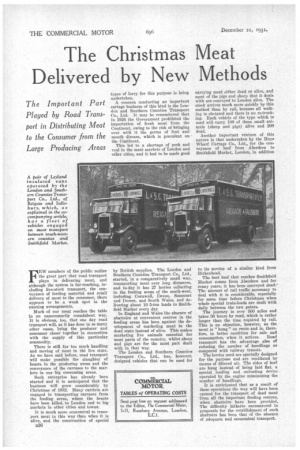The Christmas Meat Delivered by New Methods
Page 50

If you've noticed an error in this article please click here to report it so we can fix it.
The Important Part Played by Road Transport in Distributing Meat to the Consumer from the Large Producing Areas
FEW members of the public realize the great part that road transport plays in delivering meat, and although the system is far-reaching, including live-stock transport, the conveyance of feeding material and retail delivery of meat to the consumer, there appears to be a weak spot in. the existing arrangements.
Much of our meat reaches the table in an unnecessarily roundabout way. It is obvious, too, that one day road transport will, as it has done in so many other cases, bring the producer and consumer closer together in connection with the supply of this particular commodity.
There is still far too much handling and moving of meat in the live state. As we have said before, road transport will make possible the slaughter of beasts in the producing areas and the conveyance of the carcases to the markets in our big consuming areas.
Such enterprise has already been started and it is anticipated that the business will grow considerably by Christmas of 1922. Many carriers are engaged in transporting carcases from the feeding areas, where the beasts have been killed, to London and to big markets in other cities and towns.
It is much more economical to transport meat in this way than when it is alive, and the construction of special 3336 types of lorry for this purpose is being undertaken.
A concern conducting an important cartage business of this kind is the London and Southern Counties Transport Co., Ltd. It may be remembered that in 1926 the Government prohibited the importation of fresh meat from the Continent, owing to the risk of bringing over with it the germs of foot and mouth disease, which is prevalent on the Cootinent.
This led to a shortage of pork and veal in the meat markets of London and other cities, and it had to be made good by British supplies. The London and Southern Counties Transport Co., Ltd., started, in a comparatively small way, transporting meat over long distances, and to-day it has 27 lorries collecting in the feeding areas of the south-west, including Cornwall, Devon, Somerset and Dorset, and South Wales, and delivering about 10 5-ton loads to Smithfield Market every day
In England and Wales -the absence of abattoirs at convenient centres in the feeding areas has been against the development of marketing meat in the dead state instead of alive. This makes marketing live animals essential for most parts of the country, whilst sheep and pigs are for the most part dealt with in that way. The London and Southern Counties Transport Co., Ltd., has, however, designed vehicles that can be used for
carrying meat either dead or alive, and most of the pigs and sheep that it deals with are conveyed to London alive. The stock arrives much more quickly by this method than by rail, because all walking is obviated and there is no re-trucking. Each vehicle of the type which is used will carry 100 of these small animals (sheep and pigs) alive and 200 dead.
Another important venture of this nature is that undertaken by the Hays Wharf Cartage Co., Ltd., for the conveyance of beef from Aberdeen to Smithfield Market, London, in addition to its service of a similar kind from Birkenhead.
The best beef that reaches Smithfield Market comes from Aberdeen and for many years, it has been conveyed dead: The amount of rail traffic necessary to deal with it is considerable, especially for some time before Christmas when whole special train-loads are dealt with daily between the two points.
The journey is over 500 miles and takes 36 hours by road, which is rather longer than the time required by rail. This is no objection, however, as the meat is " hung " en route and is, therefore, in better condition for sale and consumption, when it arrives. Road transport has the advantage also of reducing the number of handlings as compared with railway transit.
The lorries used are specially designed for the purpose and are ventilated by means of filtered air. The sides of beef are hung instead of being laid flat, a special loading and unloading device operated by the engine mimimizing the number of handlings.
It is anticipated that as a result of these operations the way will have been opened for the transport of dead meat from all the important feeding centres, when abattoirs have been provided, The difficulty hitherto encountered in proposals for the establishment of such abattoirs has been that of the absence of adequate and economical transport.




























































































